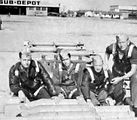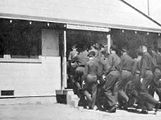
Midland-Odessa International Air and Space Port is in the city limits of Midland, Texas, about midway between Downtown Midland and Downtown Odessa, owned and operated by the City of Midland. In September 2014 it was licensed by the Federal Aviation Administration to serve commercial spaceflight.

The Norden Mk. XV, known as the Norden M series in U.S. Army service, is a bombsight that was used by the United States Army Air Forces (USAAF) and the United States Navy during World War II, and the United States Air Force in the Korean and the Vietnam Wars. It was an early tachometric design that directly measured the aircraft's ground speed and direction, which older bombsights could only estimate with lengthy manual procedures. The Norden further improved on older designs by using an analog computer that continuously recalculated the bomb's impact point based on changing flight conditions, and an autopilot that reacted quickly and accurately to changes in the wind or other effects.

Mather Air Force Base was a United States Air Force Base, which was closed in 1993 pursuant to a post-Cold War BRAC decision. It was located 12 miles (19 km) east of Sacramento, on the south side of U.S. Route 50 in Sacramento County, California. Mather Field was one of 32 Air Service training camps established after the United States entry into World War I in April 1917.

Waco Regional Airport is five miles northwest of Waco, in McLennan County, Texas. It is owned by the City of Waco.

Foster Air Force Base is a former United States Air Force facility in Texas, located in Victoria County, approximately six miles (10 km) east-northeast of Victoria.

Santa Ana Army Air Base (SAAAB) was a World War II-era air base located near Santa Ana, California. The air base was decommissioned in 1946, and part of the land was annexed by Costa Mesa in 1953. The air base was used for basic training, although it did not have planes, hangars or runways. The base was 1,336 acres (5.41 km2), and the main section of the base was located between Baker Street to the north, Harbor Boulevard to the west, Wilson Street on the south, and Newport Boulevard on the east. The land formerly occupied by the air base is today the home of John Wayne Airport, the Orange County Fairgrounds, and Orange Coast College.
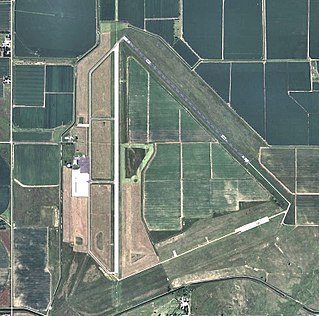
Ainsworth Regional Airport is seven miles northwest of Ainsworth, in Brown County, Nebraska. It is owned by the Ainsworth Airport Authority. The National Plan of Integrated Airport Systems for 2011–2015 called it a general aviation airport.

Sharpe Field is a closed private use airport located six nautical miles (11 km) northwest of the central business district of Tuskegee, a city in Macon County, Alabama, United States. This airport is privately owned by the Bradbury Family Partnership.

Bombardier is a 1943 film war drama about the training program for bombardiers of the United States Army Air Forces. The film stars Pat O'Brien and Randolph Scott. Bombardier was nominated for an Oscar in 1944 for the special effects used in the film. It was largely filmed at Kirtland Army Air Field, New Mexico, site of the first bombardier training school.
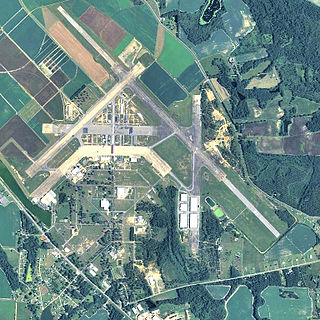
Spence Air Base was a United States Air Force base that operated from 1941 to 1961. It was later reopened as Spence Airport.

The US Army Air Forces in WWII had major subordinate Commands below the Air Staff level. These Commands were organized along functional missions. One such Command was the Flying Training Command (FTC). It began as Air Corps Flying Training Command on 23 January 1942, was redesignated Army Air Forces Flying Training Command (AAFTC) on 15 March 1942, and merged with Army Air Forces Technical Training Command to become Army Air Forces Training Command on 31 July 1943. Continuing service after the war, it was redesignated Air Training Command on 1 July 1946. During the consolidation of Air Force Major Commands in the retrenchment of the 1990s, Air Training Command assumed control of Air University and became Air Education and Training Command on 1 July 1993—today's Air Education and Training Command (AETC), which celebrated its 75th anniversary 23 January 2017. see the Lineage and honors statement for AETC.
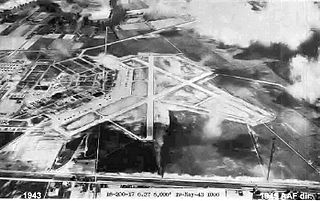
Selman Army Airfield is an inactive United States Air Force base, approximately 7.7 miles east of Monroe, Louisiana. It was active during World War II as an Army Air Forces Training Command airfield. It was closed on 1 September 1945.
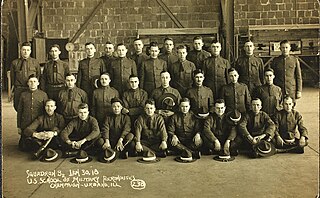
The Flying / Aviation Cadet Pilot Training Program was originally created by the U.S. Army to train its pilots. Originally created in 1907 by the U.S. Army Signal Corps, it expanded as the Army's air assets increased. Candidates originally had to be between the ages of 19 and 25, athletic, and honest. Two years of college or three years of a scientific or technical education were required. Cadets were supposed to be unmarried and pledged not to marry during training. From 1907 to 1920, pilot officers were considered part of the Signal Corps or the Signal Officer Reserve Corps. After 1920, they were considered part of their own separate organization, the U.S. Army Air Service (1918–1926).

San Angelo Army Airfield is an inactive United States Air Force base, about 8 miles south-southwest of San Angelo, Texas. It was active during World War II as a training airfield. It was closed on 30 November 1945.

Childress Army Airfield is a former World War II military airfield, located 4.8 miles west of Childress, Texas. It operated as a Bombardier training school for the United States Army Air Forces from 1942 until 1945.

Freeman Army Airfield is an inactive United States Army Air Forces base. It is located 2.6 miles (4.2 km) south-southwest of Seymour, Indiana.

Flying Division, Air Training Command is an inactive United States Air Force unit. It was last assigned to Air Training Command, stationed at Randolph Air Force Base, Texas. It was inactivated on 14 November 1949.

A Bombardier School was a United States Army Air Forces facility that used bombing ranges for training aircrew. After ground simulator training with the Norden bombsight, the 12- to 18-week course recorded each student's scores for approximately 160 practice bomb drops of "Bomb Dummy Units" (BDU), both in daytime and at night. The elimination rate was 12%, and graduates transferred to a Second or Third Air Force training unit to join a crew being trained for overseas duty. The bombardier trainer used was the Beech AT-11 Kansan. With the Bradley Plan increase in Eighth Air Force aircrews needed for the Combined Bomber Offensive, the 17 Army Air Forces Bombardier Schools graduated 47,236.
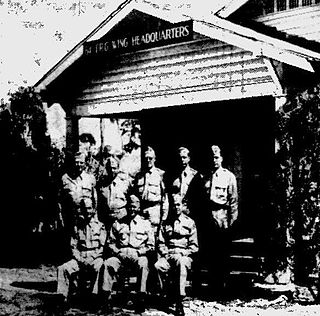
The St. Petersburg Training Center is a closed United States Air Force facility that was located in St. Petersburg, Florida. It was last assigned to the United States Army Air Forces Personnel Distribution Command. It was closed in 1945.

Webb Air Force Base, previously named Big Spring Air Force Base, was a United States Air Force facility of the Air Training Command that operated from 1951 to 1977 in West Texas within the current city limits of Big Spring. Webb AFB was a major undergraduate pilot training (UPT) facility for the Air Force, and by 1969, almost 9,000 pilots had been trained at Webb. The last operational wing at Webb AFB was the 78th Flying Training Wing.





